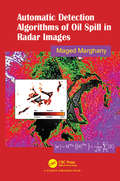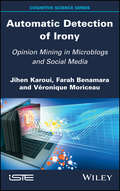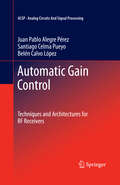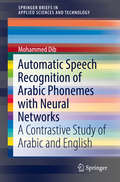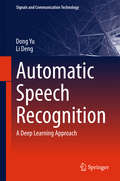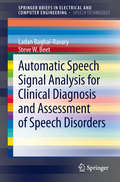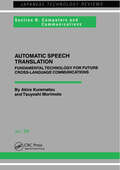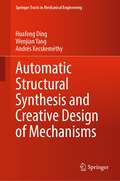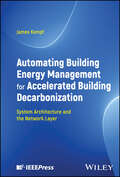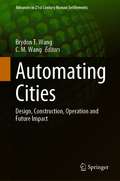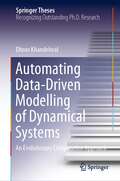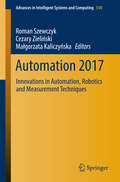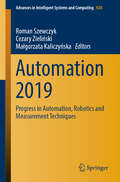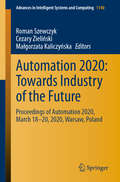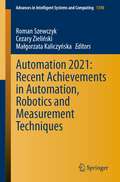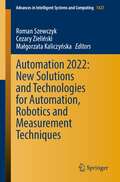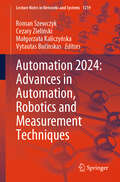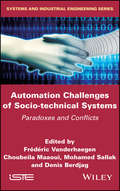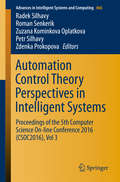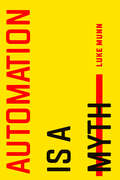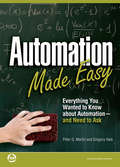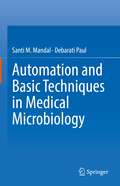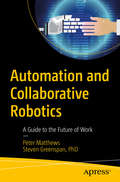- Table View
- List View
Automatic Detection Algorithms of Oil Spill in Radar Images
by Maged MarghanySynthetic Aperture Radar Automatic Detection Algorithms (SARADA) for Oil Spills conveys the pivotal tool required to fully comprehend the advanced algorithms in radar monitoring and detection of oil spills, particularly quantum computing and algorithms as a keystone to comprehending theories and algorithms behind radar imaging and detection of marine pollution. Bridging the gap between modern quantum mechanics and computing detection algorithms of oil spills, this book contains precise theories and techniques for automatic identification of oil spills from SAR measurements. Based on modern quantum physics, the book also includes the novel theory on radar imaging mechanism of oil spills. With the use of precise quantum simulation of trajectory movements of oil spills using a sequence of radar images, this book demonstrates the use of SARADA for contamination by oil spills as a promising novel technique. Key Features: Introduces basic concepts of a radar remote sensing. Fills a gap in the knowledge base of quantum theory and microwave remote sensing. Discusses the important aspects of oil spill imaging in radar data in relation to the quantum theory. Provides recent developments and progresses of automatic detection algorithms of oil spill from radar data. Presents 2-D oil spill radar data in 4-D images.
Automatic Detection of Irony: Opinion Mining in Microblogs and Social Media
by Jihen Karoui Farah Benamara Veronique MoriceauIn recent years, there has been a proliferation of opinion-heavy texts on the Web: opinions of Internet users, comments on social networks, etc. Automating the synthesis of opinions has become crucial to gaining an overview on a given topic. Current automatic systems perform well on classifying the subjective or objective character of a document. However, classifications obtained from polarity analysis remain inconclusive, due to the algorithms' inability to understand the subtleties of human language. Automatic Detection of Irony presents, in three stages, a supervised learning approach to predicting whether a tweet is ironic or not. The book begins by analyzing some everyday examples of irony and presenting a reference corpus. It then develops an automatic irony detection model for French tweets that exploits semantic traits and extralinguistic context. Finally, it presents a study of portability in a multilingual framework (Italian, English, Arabic).
Automatic Gain Control: Techniques and Architectures for RF Receivers (Analog Circuits and Signal Processing)
by Juan Pablo Alegre Pérez Belén Calvo López Santiago Celma PueyoThis book analyzes automatic gain control (AGC) loop circuits and demonstrates AGC solutions in the environment of wireless receivers, mainly in wireless receivers with stringent constraints in settling-time and wide dynamic range, such as WLAN and Bluetooth receivers. Since feedforward AGCs present great advantages in this context, as an alternative to conventional feedback AGCs, this book includes a detailed study of feedforward AGCs design -at the level of basic AGC cells, as well as the system level, including their main characteristics and performance.
Automatic Modulation Classification
by Asoke K. Nandi Zhechen ZhuAutomatic Modulation Classification (AMC) has been a key technology in many military, security, and civilian telecommunication applications for decades. In military and security applications, modulation often serves as another level of encryption; in modern civilian applications, multiple modulation types can be employed by a signal transmitter to control the data rate and link reliability.This book offers comprehensive documentation of AMC models, algorithms and implementations for successful modulation recognition. It provides an invaluable theoretical and numerical comparison of AMC algorithms, as well as guidance on state-of-the-art classification designs with specific military and civilian applications in mind.Key Features:Provides an important collection of AMC algorithms in five major categories, from likelihood-based classifiers and distribution-test-based classifiers to feature-based classifiers, machine learning assisted classifiers and blind modulation classifiersLists detailed implementation for each algorithm based on a unified theoretical background and a comprehensive theoretical and numerical performance comparisonGives clear guidance for the design of specific automatic modulation classifiers for different practical applications in both civilian and military communication systemsIncludes a MATLAB toolbox on a companion website offering the implementation of a selection of methods discussed in the book
Automatic Speech Recognition of Arabic Phonemes with Neural Networks: A Contrastive Study of Arabic and English (SpringerBriefs in Applied Sciences and Technology)
by Mohammed DibThis book presents a contrastive linguistics study of Arabic and English for the dual purposes of improved language teaching and speech processing of Arabic via spectral analysis and neural networks. Contrastive linguistics is a field of linguistics which aims to compare the linguistic systems of two or more languages in order to ease the tasks of teaching, learning, and translation. The main focus of the present study is to treat the Arabic minimal syllable automatically to facilitate automatic speech processing in Arabic. It represents important reading for language learners and for linguists with an interest in Arabic and computational approaches.
Automatic Speech Recognition: A Deep Learning Approach (Signals and Communication Technology)
by Dong Yu Li DengThis book provides a comprehensive overview of the recent advancement in the field of automatic speech recognition with a focus on deep learning models including deep neural networks and many of their variants. This is the first automatic speech recognition book dedicated to the deep learning approach. In addition to the rigorous mathematical treatment of the subject, the book also presents insights and theoretical foundation of a series of highly successful deep learning models.
Automatic Speech Signal Analysis for Clinical Diagnosis and Assessment of Speech Disorders (SpringerBriefs in Speech Technology)
by Steve W. Beet Ladan Baghai-RavaryAutomatic Speech Signal Analysis for Clinical Diagnosis and Assessment of Speech Disorders provides a survey of methods designed to aid clinicians in the diagnosis and monitoring of speech disorders such as dysarthria and dyspraxia, with an emphasis on the signal processing techniques, statistical validity of the results presented in the literature, and the appropriateness of methods that do not require specialized equipment, rigorously controlled recording procedures or highly skilled personnel to interpret results. Such techniques offer the promise of a simple and cost-effective, yet objective, assessment of a range of medical conditions, which would be of great value to clinicians. The ideal scenario would begin with the collection of examples of the clients' speech, either over the phone or using portable recording devices operated by non-specialist nursing staff. The recordings could then be analyzed initially to aid diagnosis of conditions, and subsequently to monitor the clients' progress and response to treatment. The automation of this process would allow more frequent and regular assessments to be performed, as well as providing greater objectivity.
Automatic Speech Translation
by Akira KurematsuAutomatic Speech Translation introduces recent results of Japanese research and development in speech translation and speech recognition. Topics covered include: fundamental concepts of speech recognition; speech pattern representation; phoneme-based HMM phoneme recognition; continuous speech recognition; speaker adaptation; speaker-independent speech recognition; utterance analysis, utterance transfer, utterance generation; contextual processing; speech synthesis and an experimental system of speech translation. This book presents the complicated technological aspects of machine translation and speech recognition, and outlines the future directions of this rapidly developing area of technology.
Automatic Structural Synthesis and Creative Design of Mechanisms (Springer Tracts in Mechanical Engineering)
by Andrés Kecskeméthy Huafeng Ding Wenjian YangThis book provides a comprehensive overview of the current research status and open problems in the field of structural synthesis, based on which a systematic methodology for the structural analysis of planar kinematic chains, structural synthesis of planar kinematic chains, and creative design of mechanisms is presented.The method presented in this book not only promotes the development of theoretical research in the field of mechanical science, and the development of industrial software for the creative design of mechanisms, but also generates novel high-performance mechanisms suitable for industrial application, which can improve the work efficiency and economic benefits. This book offers theoretical guidance for students and researchers engaged in the field of mechanical engineering, especially the creative design of mechanism.
Automating Building Energy Management for Accelerated Building Decarbonization: System Architecture and the Network Layer
by James KempfComplete, up-to-date reference on system architecture for building energy management systems Automating Building Energy Management for Accelerated Building Decarbonization delivers detailed technical information on building energy management control technology and guidelines to implementing and deploying building energy management systems. The book provides a detailed look at the system architecture of cloud-based building energy management systems, and a comprehensive review of technology for the networking layer, from the link layer through the application layer. Wired and wireless link layer protocols, and Internet network layer protocols from the TCP/IP suite are thoroughly reviewed, and discussed in the context of deploying an in-building, operational technology network. At the application layer, BACnet, for large commercial and government buildings, and Bluetooth Low Energy, Zigbee, and Matter, for smaller commercial and residential buildings, are discussed in detail, with focus on energy management and building decarbonization. The API standards OpenAPI 3.1 and AsyncAPI 3.0 are used to define example APIs for controlling an HVAC system, illustrating how to provide API abstractions that simplify the development of building energy management applications and services. Finally, a discussion of controlling onsite distributed energy resources, such as solar panels and on-site battery storage, through SunSpec Modbus, and communicating with the utility through OpenADR and IEEE 2030.5 provide a solid technical foundation for implementing communication services in demand response and flexible load applications. Security is emphasized as a key property for the operational technology networks that run building energy systems up and down the stack. At the architectural level, security functions including data origin authentication, confidentiality protection, and key exchange are discussed in detail. Detailed information on security protocols including IPsec at the network layer, TLS at the transport layer, and Oauth2.0 at the application layer is presented. In addition, advice on deploying security solutions in building energy management networks is provided. Throughout the book, QR codes provide access to short videos about topics where more depth is needed or that are only briefly covered. These allow the reader to view more information about important topics. Automating Building Energy Management for Accelerated Building Decarbonization is an essential resource for managers, engineers, and other professionals involved in designing and building energy management services for commercial and residential buildings. It is also an excellent reference for university and training courses related to building decarbonization and renewable energy.
Automating Cities: Design, Construction, Operation and Future Impact (Advances in 21st Century Human Settlements)
by C. M. Wang Brydon T. WangThis book highlights the latest advancements in the use of automated systems in the design, construction, operation and future of the built environment and its occupants. It considers how the use of automated decision-making frameworks, artificial intelligence and other technologies of automation are presently impacting the practice of architects, engineers, project managers and contractors, and articulates the near future changes to workflows, legal frameworks and the wider AEC industry. This book surveys and compiles the use of city apps, robots that operate buildings and fabricate structural elements, 3D printing, drones, sensors, algorithms, and advanced prefabricated modules. The book also contributes to the growing literature on smart cities, and explores the impacts on data privacy and data sovereignty that arise through the use of sensors, digital twins and intelligent transport systems. It provides a useful reference for further research and development in the area of automation in design and construction to architects, engineers, project managers, superintendents and construction lawyers, contractors, policy makers, and students.
Automating Data-Driven Modelling of Dynamical Systems: An Evolutionary Computation Approach (Springer Theses)
by Dhruv KhandelwalThis book describes a user-friendly, evolutionary algorithms-based framework for estimating data-driven models for a wide class of dynamical systems, including linear and nonlinear ones. The methodology addresses the problem of automating the process of estimating data-driven models from a user’s perspective. By combining elementary building blocks, it learns the dynamic relations governing the system from data, giving model estimates with various trade-offs, e.g. between complexity and accuracy. The evaluation of the method on a set of academic, benchmark and real-word problems is reported in detail. Overall, the book offers a state-of-the-art review on the problem of nonlinear model estimation and automated model selection for dynamical systems, reporting on a significant scientific advance that will pave the way to increasing automation in system identification.
Automation 2017: Innovations in Automation, Robotics and Measurement Techniques (Advances in Intelligent Systems and Computing #550)
by Roman Szewczyk Małgorzata Kaliczyńska Cezary ZielińskiThis book consists of papers presented at Automation 2017, an international conference held in Warsaw from March 15 to 17, 2017. It discusses research findings associated with the concepts behind INDUSTRY 4. 0, with a focus on offering a better understanding of and promoting participation in the Fourth Industrial Revolution. Each chapter presents a detailed analysis of a specific technical problem, in most cases followed by a numerical analysis, simulation and description of the results of implementing the solution in a real-world context. The theoretical results, practical solutions and guidelines presented are valuable for both researchers working in the area of engineering sciences and practitioners looking for solutions to industrial problems.
Automation 2018: Advances In Automation, Robotics And Measurement Techniques (Advances In Intelligent Systems And Computing #743)
by Roman Szewczyk Małgorzata Kaliczyńska Cezary ZielińskiThis book consists of papers presented at Automation 2018, an international conference held in Warsaw from March 21 to 23, 2018. It discusses the radical technological changes occurring due to the INDUSTRY 4.0, with a focus on offering a better understanding of the Fourth Industrial Revolution. Each chapter presents a detailed analysis of interdisciplinary knowledge, numerical modeling and simulation as well as the application of cyber-physical systems, where information technology and physical devices create synergic systems leading to unprecedented efficiency. The theoretical results, practical solutions and guidelines presented are valuable for both researchers working in the area of engineering sciences and practitioners looking for solutions to industrial problems.
Automation 2019: Progress in Automation, Robotics and Measurement Techniques (Advances in Intelligent Systems and Computing #920)
by Roman Szewczyk Małgorzata Kaliczyńska Cezary ZielińskiThis book consists of papers presented at AUTOMATION2019, an international conference held in Warsaw from March 27 to 29, 2019. It discusses the radical technological changes occurring due to the INDUSTRY 4.0. To follow these changes, both scientists and engineers have to face the challenge of interdisciplinary approach directed at the development of cyber-physical systems. This approach encompasses interdisciplinary theoretical knowledge, numerical modelling and simulation as well as application of artificial intelligence techniques. Both software and physical devices are composed into systems that will increase production efficiency and resource savings. The theoretical results, practical solutions and guidelines presented are valuable for both researchers working in the area of engineering sciences and practitioners looking for solutions to industrial problems.
Automation 2020: Proceedings of Automation 2020, March 18–20, 2020, Warsaw, Poland (Advances in Intelligent Systems and Computing #1140)
by Roman Szewczyk Małgorzata Kaliczyńska Cezary ZielińskiThis book presents the scientific outcomes of the International Conference AUTOMATION 2020, held on March 18–20, 2020 in Warsaw, Poland. The next 30 years will see radical innovations in production processes, transportation management and social life. The changes brought about by the transformation to zero-emission industry require advances in many fields, but especially in industrial automation, robotics and measurement techniques associated with the cyber-physical systems employing artificial intelligence that will be key to reducing costs and enabling European society to maintain its quality of live. In this context, the book features the latest research toward further developing these fields of engineering, and also offers solutions and guidelines that are useful for both researchers and engineers addressing problems associated with the world of ongoing radical changes.
Automation 2021: Recent Achievements in Automation, Robotics and Measurement Techniques (Advances in Intelligent Systems and Computing #1390)
by Roman Szewczyk Małgorzata Kaliczyńska Cezary ZielińskiThis book contains 38 papers authored by both scientists and practitioners focused on an interdisciplinary approach to the development of cyber-physical systems. Recently our civilization has been facing one of the most severe challenges in modern history. The COVID-19 pandemic devastated the global economy and significantly disrupted numerous areas of economic activity. Only radical increase of efficiency and versatility of industrial production, with further limitation of human involvement, paralleled by the decrease of environmental burden, will enable us to cope with such challenges. We hope that the presented book provides input to the solution of at least some problems brought about by this challenge. This approach relies on the development of measuring techniques, robotic and mechatronic systems, industrial automation, numerical modeling and simulation as well as application of artificial intelligence techniques required by the transformation leading to Industry 4.0.
Automation 2022: New Solutions and Technologies for Automation, Robotics and Measurement Techniques (Advances in Intelligent Systems and Computing #1427)
by Roman Szewczyk Małgorzata Kaliczyńska Cezary ZielińskiThis book presents the unique result of discussion among interdisciplinary specialists facing recent industrial and economic challenges. It contains papers authored by both scientists and practitioners focused on an interdisciplinary approach to developing measuring techniques, robotic and mechatronic systems, industrial automation, numerical modelling and simulation, and application of artificial intelligence techniques required by the transformation leading to Industry 4.0. We strongly believe that the solutions and guidelines presented in this book will be useful to both researchers and engineers facing problems associated with developing cyber-physical systems for global development.
Automation 2024: Advances in Automation, Robotics and Measurement Techniques (Lecture Notes in Networks and Systems #1219)
by Roman Szewczyk Małgorzata Kaliczyńska Cezary Zieliński Vytautas BučinskasThis book presents the result of the most recent discussion among interdisciplinary specialists facing scientific and industrial challenges. The papers presented during the Automation 2024 Conference deal with applying artificial neural networks and other machine learning methods in perception, modelling, and control, utilization of fractional order systems, and novel sensors and measurement techniques. Recent developments in robotics and the quality of exerted control and optimization are also prominent in this volume. Specific aspects of the design of diverse robots and their modelling and control are described in depth. We strongly believe that the solutions and guidelines presented in this book will be useful to both researchers and engineers during the development of automation, robotics, and measurement systems in a rapidly changing global industry.
Automation Challenges of Socio-technical Systems: Paradoxes and Conflicts
by Mohamed Sallak Frédéric Vanderhaegen Choubeila Maaoui Denis BerdjagThe challenges of automating socio-technical systems are strongly linked to the strengths and limitations of technical and human resources, such as perceptual characteristics, cooperative capacities, job-sharing arrangements, modeling of human behavior and the contribution of innovative design approaches. Automation Challenges of Socio-technical Systems exposes the difficulties in implementing and sustaining symbiosis between humans and machines in both the short and long terms. Furthermore, it presents innovative solutions for achieving such symbiosis, drawing on skills from cognitive sciences, engineering sciences and the social sciences. It is aimed at researchers, academics and engineers in these fields.
Automation Control Theory Perspectives in Intelligent Systems: Proceedings of the 5th Computer Science On-line Conference 2016 (CSOC2016), Vol 3 (Advances in Intelligent Systems and Computing #466)
by Radek Silhavy Roman Senkerik Zuzana Kominkova Oplatkova Petr Silhavy Zdenka ProkopovaThe volume Automation Control Theory Perspectives in Intelligent Systems presents new approaches and methods to real-world problems, and in particular, exploratory research that describes novel approaches in the field of cybernetics and automation control theory. Particular emphasis is laid on modern trends in intelligent information technology, system monitoring and proactive management of complex objects The 5th Computer Science On-line Conference (CSOC2016) is intended to provide an international forum for discussions on the latest high-quality research results in all areas related to Computer Science. The addressed topics are the theoretical aspects and applications of Computer Science, Artificial Intelligences, Cybernetics, Automation Control Theory and Software Engineering.
Automation Is a Myth
by Luke MunnFor some, automation will usher in a labor-free utopia; for others, it signals a disastrous age-to-come. Yet whether seen as dream or nightmare, automation, argues Munn, is ultimately a fable that rests on a set of triple fictions. There is the myth of full autonomy, claiming that machines will take over production and supplant humans. But far from being self-acting, technical solutions are piecemeal; their support and maintenance reveals the immense human labor behind "autonomous" processes. There is the myth of universal automation, with technologies framed as a desituated force sweeping the globe. But this fiction ignores the social, cultural, and geographical forces that shape technologies at a local level. And, there is the myth of automating everyone, the generic figure of "the human" at the heart of automation claims. But labor is socially stratified and so automation's fallout will be highly uneven, falling heavier on some (immigrants, people of color, women) than others. Munn moves from machine minders in China to warehouse pickers in the United States to explore the ways that new technologies do (and don't) reconfigure labor. Combining this rich array of human stories with insights from media and cultural studies, Munn points to a more nuanced, localized, and racialized understanding of the "future of work."
Automation Made Easy: Everything You Wanted to Know about Automation-and Need to Ask
by Peter G. Martin Gregory HaleAfter a quick glance at the plant floor, it is very easy to see the industrial automation industry interoperates with other functions within the enterprise. Trying to keep up with changing technologies, however, is never easy and the industrial automation environment is no exception. Whether you are a student just starting out or are a top-level executive or manager well-versed in one domain, but have limited knowledge of the industrial automation industry, it's easy to find yourself adrift in this evolving industry. That is where this easy-to-read book comes in; it provides a basic functional understanding in the field of industrial automation. In an effort to understand this industry, the authors break down the barriers and confusion surrounding the technical details and terminology used in this converging field. They provide an introductory-level approach, covering most of the major industrial automation topics, such as distributed control systems (DCSs), programmable logic controllers (PLCs), manufacturing execution systems (MESs), and so on. You may even learn a recipe or two. This book is ideal for executives, business managers, information technologists, accountants, maintenance professionals, operators, production planners, just to name a few, and provides an in-depth but easy overview for people new to the field who want to quickly educate themselves.
Automation and Basic Techniques in Medical Microbiology
by Santi M. Mandal Debarati PaulThis book discusses principles, methodology, and applications of microbiological laboratory techniques . It lays special emphasis on the use of various automated machines that are essential for medical microbiology and diagnostic labs. The book contains eleven major chapters. The first chapter describes the good lab practices which should be followed by the students in all biological, chemistry or microbiology laboratories. The next chapter describes manual and automated characterization of antibiotic resistant microbes, followed by a chapter on genomics based tools and techniques that are integral to research. Further chapters deal with other important techniques like immunology based techniques, spectrophotometry and its various types, MALDI-TOFF and microarrays, each with illustrations and detailed description of the protocols and applications. The book also gives certain important guidelines to the students about the planning the experiment and interpreting results.The book is highly informative and provides latest techniques. It is a handy compendium for graduate and post graduate students, as well as more advanced researchers.
Automation and Collaborative Robotics: A Guide to the Future of Work
by Peter Matthews Steven GreenspanUnderstand the current and future research into technologies that underpin the increasing capabilities of automation technologies and their impact on the working world of the future.Rapid advances in automation and robotics technologies are often reported in the trade and general media, often relying on scary headlines such as “Jobs Lost to Robots.” It is certainly true that work will change with the advent of smarter and faster automated workers; however, the scope and scale of the changes is still unknown. Automation may seem to be here already, but we are only at the early stages. Automation and Collaborative Robotics explores the output of current research projects that are improving the building blocks of an automated world. Research into collaborative robotics (cobotics) is merging digital, audio, and visual data to generate a commonly held view between cobots and their human collaborators. Low-power machine learning at the edge of the network can deliver decision making on cobots or to their manipulations. Topics covered in this book include: Robotic process automation, chatbots, and their impact in the near futureThe hype of automation and headlines leading to concerns over the future of workComponent technologies that are still in the research labsFoundational technologies and collaboration that will enable many tasks to be automated with human workers being re-skilled and displaced rather than replaced What You Will Learn Be aware of the technologies currently being researched to improve or deliver automationUnderstand the impact of robotics, other automation technologies, and the impact of AI on automationGet an idea of how far we are from implementation of an automated futureKnow what work will look like in the future with the deployment of these technologies Who This Book Is For Technical and business managers interested in the future of automation and robotics, and the impact it will have on their organizations, customers, and the business world in general
